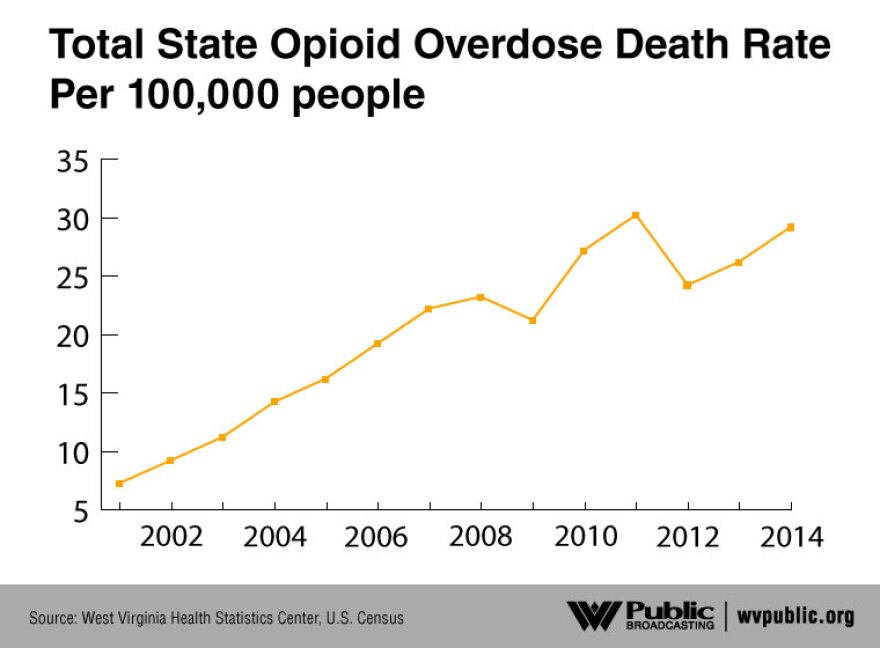Kristina “Breezy” Weaver lives in Wyoming County, which has one of the highest drug overdose death rates in a state that leads the country in drug overdose deaths. Last June, Weaver’s father died of a heroin overdose.
“He loved to tell stories,” Weaver told Jessica Lilly on a recent episode of Inside Appalachia. “I think I miss him a lot because of how carefree he would act. He would always lift me up because I was his baby girl.”
It turns out that location has a larger influence on one’s health and likelihood to become addicted to drugs than the quality of healthcare available in that area. Rahul Gupta, the West Virginia state health officer and the commissioner for the Bureau for Public Health, said that national research shows that instances of drug addiction don’t occur in silos.
“What matters to health is where they live, where they learn, where they play, where they pray, where they meet friends,” Gupta said. “Those communities where individuals live tend to dictate a lot more about the health condition both in terms of survival and quality of life.”
The five counties with the highest per-capita drug overdose-related death rates are concentrated in the southern parts of the state. All of them are coal-communities. According to a 2016 study by West Virginia University’s Bureau of Business and Economic Research, Boone, Mingo and Wyoming counties are three of six counties in the state experiencing an economic downturn similar to that of the Great Depression in the 1930s.
Those poor economies could be influencing addiction rates. A study by the Department of Health and Human Resources found that between 2010-2014, adults with incomes lower than $25,000 in counties with the highest drug overdose rates (Boone, Logan, McDowell, Mercer, Mingo, Raleigh and Wyoming) were significantly more likely to suffer from poor health, obesity, cardiovascular disease and depression than other counties did.
The difference between those counties with the highest overdose rates and the rest of the state was even greater for women with a high school degree or less.
“When we talk about the gender gap, it matters especially for women because the core structure of a family is a woman,” Gupta said. “In a lot of West Virginia families, it’s the woman who’s setting the cultural example of consumption and healthy habits.”
The drug overdose epidemic affects the entire United States, not just Appalachia. According to the Centers for Disease Control and Prevention, between 1999 and 2014, 165,000 individuals died of opioid-related overdoses. The number of opioid-related overdose deaths quadrupled between 2010 and 2014.
That’s taking a toll on families throughout the country.
In east Tennessee, Vince Brown’s son Michael Brown became addicted to prescription painkillers after an injury ended his baseball career. Three years ago, Michael attacked Vince in his home in Tennessee for refusing to give him money. Vince feared for the safety of his wife and granddaughter, who were also in the house.
“So I shot him, with no intention to hurt him. I just was trying to stop (him). But he died. My granddaughter, she knew what her daddy was doing, she just – it’s hard for an eleven-year-old to comprehend and accept that,” Vince told WOUT reporter Jess Mador. “She wrote on her bedroom wall, ‘I love my daddy.’ And that’s ok. Because I know she does. And she always will, and so will my wife, and so will I.” His story was featured in the podcast Truckbeat, and on Inside Appalachia.
More than half of opioid addictions today are caused by prescription painkillers. West Virginia has the highest per-capita prescription rate for opioids in the nation. Starting in January, doctors in West Virginia will be required to follow CDC prescription guidelines, which encourage doctors to prescribe opioid prescriptions as a last resort, and to thoroughly warn patients about its addictive nature.
Appalachia Health News is a project of West Virginia Public Broadcasting, with support from the Benedum Foundation.























